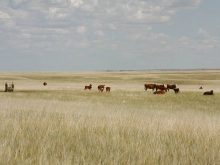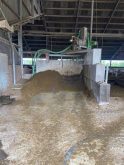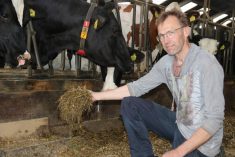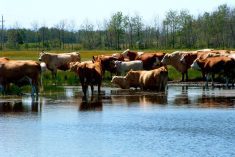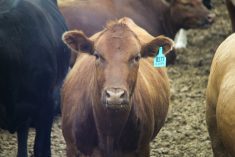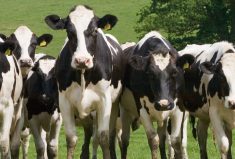What is composted manure worth? On one end of the scale, an urban gardener tossing it into the trunk of the car might pay $2.59 retail for a 20-kg bag and think nothing of it.
At the other end, a beef producer or feedlot operator cleaning out pens full of the raw materials for making top-notch compost is likely to call in the spreader trucks with the sole aim of getting it out of the way before the next intake of calves or finishers.
But if you look at the benefits of using composted manure on high-value crops such as potatoes, strawberries, or carrots, it’s easily worth $200 per tonne, according to Katherine Buckley, a research scientist at AAFC Brandon.
Read Also

Pig transport stress costs pork sector
Popular livestock trailer designs also increase pig stress during transportation, hitting at meat quality, animal welfare and farm profit, Agriculture and Agri-Food Canada researcher says
“It’s too bad, but historically, a lot of value hasn’t been attached to manure,” said Buckley, who has done extensive research on composting manure from the facility’s 1,000-head feedlot and wintering yard.
SUCH A WASTE
“My uncle used to have a dairy in Alberta, and the barn was perched right on a hill. There was a gangplank coming from the back door and we just pushed the wheelbarrow down and tipped it. He had a mountain of manure which is now 50 years old,” she said, adding that it’s now probably covered with a crop of very lush quackgrass.
“It’s such a waste. You can’t buy stuff that good.”
The research farm has been applying compost to zero-t ill testing areas north of Brandon in a nine-year study, then monitoring how long it takes to “mine” the nutrients from it via a range of annual and perennial forage cropping rotations. It’s a work in progress, but so far it appears that 20 tonnes per acre may be enough to supply the majority of annual crop nutrient needs for up to three years, she said.
ECONOMICS
A 2002 study found that it was more economical to use compost than chemical fertilizer.
“And that was when fertilizer prices were low. Now that they are astronomically high, there’s going to be an incredible amount of value,” she said. “In fact, studies done globally have demonstrated that on poor soils the value of compost is about $200 a tonne.”
Because compost tends to be higher in phosphorus than nitrogen, and compost nutrients are broken down slowly in the soil, research shows that the best results – especially in dry years – come from adding a side-banded dash of supplementary nitrogen. That’s because the chemical form is more freely available to plants whether it rains or not.
“If you’re relying on compost as your only fertilizer, there will be years that you’re going to be disappointed.”
On the other hand, manure sparks higher microbial activity, which releases more immobilized “native” nitrogen already present in the soil.
“With supplemental N, you get the crop off to a good start and roots established so that it can exploit all those nutrients which mineralize over the season,” she said. On zero-till plots, the compost acts like a surface mulch, which helps to retain soil moisture.
NUTRIENT BALANCE
Compost made at the research farm, which uses manure and bedding straw cleaned out of the pens, tends to be lower in nitrogen and phosphorus than typical feedlot manure because the herd is mainly cows and calves fed alfalfa-grass hay and barley silage instead of a grain-heavy diet.
The wintering yard and feedlot has been built on a heavy clay base with run-off basins, and the animals are provided with generous amounts of wheat straw for bedding. The clay prevents leaching of liquids into the soil and affecting groundwater, and the straw does a good job of soaking up the urine.
From that, each year, AAFC Brandon produces about 4,000 tonnes of compost.
The manure in the composting windrows, at between 62 to 70 per cent moisture, tends to be wetter than the ideal of 55 per cent, but frequent turnings during the first month of composting help to dry it out. Too much moisture crowds out the spaces between particles with water instead of air, and slows down the work of aerobic bacteria.
TURNOVER
On the other hand, too frequent turning not only wastes fuel, but it also accelerates the loss of nitrogen as a gas. It could also leave the compost excessively dry.
Monitoring the temperature with a long probe is important. When it falls to 50C in the first three weeks, the piles are turned to maintain a target of 55 to 63C, which is hot enough to roast pathogens.
Some types of compost , such as wood chips, sawdust or bark, can get so hot that they spontaneously combust, but most animal manures – with the possible exception of chicken manure – don’t carry that risk.
The heat generated by composting is considerable, and some companies have developed heat exchangers to capture the free energy for use in heating greenhouses.
Research is sparse on the value of light applications of compost on pastures, but it is undoubtedly superior to raw manure, she said, and offers the option of immediate grazing without the risk of pathogen intake by livestock.
One unresolved question in the whole system of feeding forages to livestock and composting the manure, she admitted, is how to maintain nutrient levels on the hayfields if the raw materials aren’t hauled back to where they came from.
“It’s difficult. I think the investigation into sustainable agricultural systems is still in its infancy.” [email protected]






